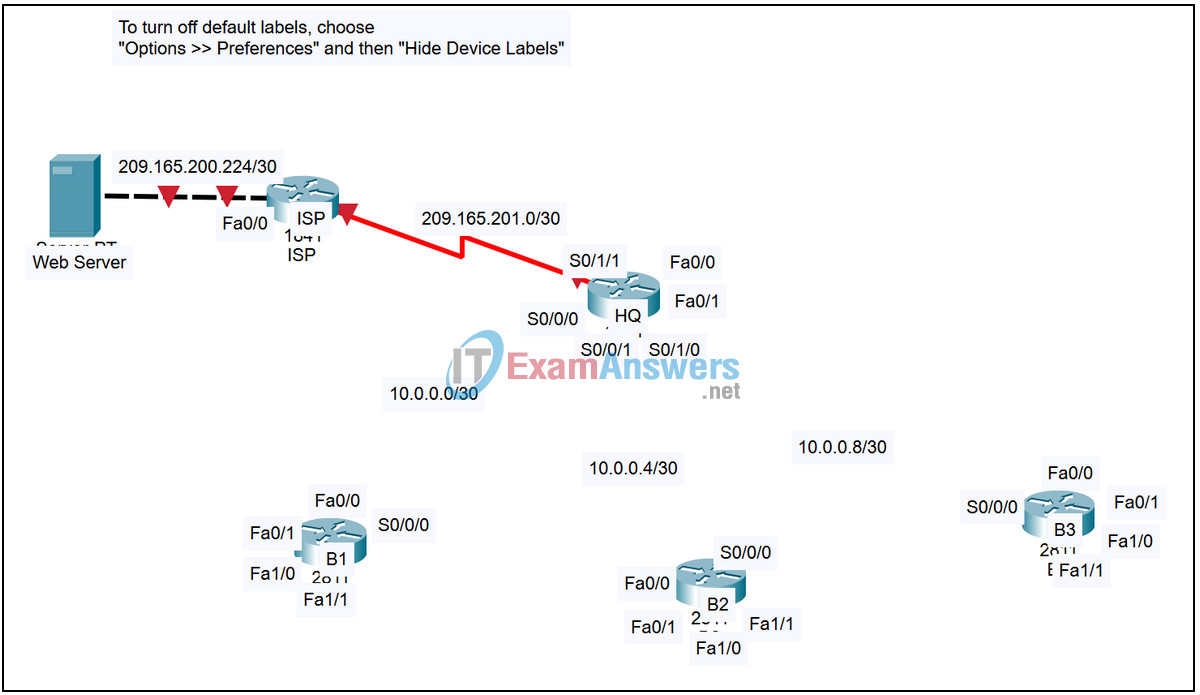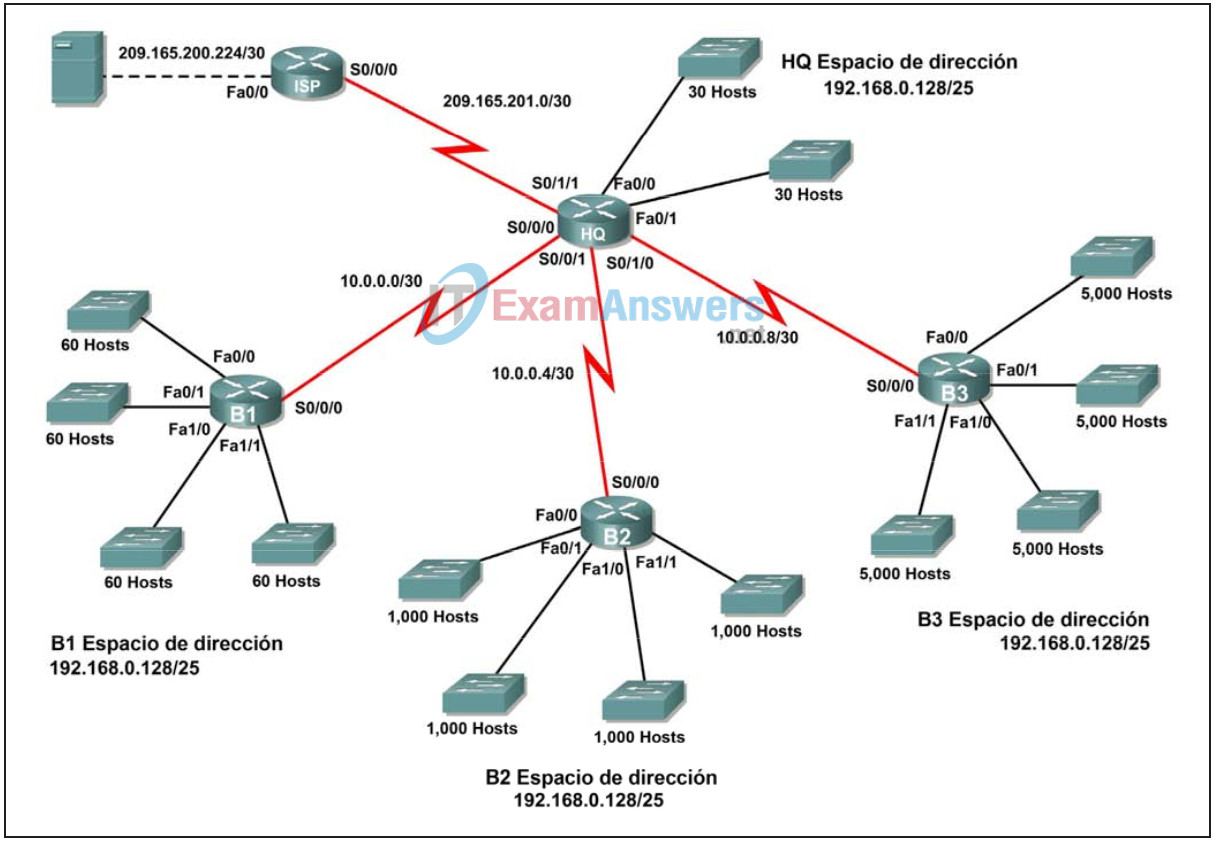3.6.1 Packet Tracer – Skills Integration Challenge Answers
Topology


Addressing table
| Device | Interface | IP address | Subnet mask |
|---|---|---|---|
| HQ | Fa0/0 | 192.168.0.129 | 255.255.255.224 |
| Fa0/1 | 192.168.0.161 | 255.255.255.224 | |
| S0/0/0 | 10.0.0.1 | 255.255.255.252 | |
| S0/0/1 | 10.0.0.5 | 255.255.255.252 | |
| S0/1/0 | 10.0.0.9 | 255.255.255.252 | |
| S0/1/1 | 209.165.201.2 | 255.255.255.252 | |
| B1 | Fa0/0 | 192.168.1.1 | 255.255.255.192 |
| Fa0/1 | 192.168.1.65 | 255.255.255.192 | |
| Fa1/0 | 192.168.1.129 | 255.255.255.192 | |
| Fa1/1 | 192.168.1.193 | 255.255.255.192 | |
| S0/0/0 | 10.0.0.2 | 255.255.255.252 | |
| B2 | Fa0/0 | 172.16.0.1 | 255.255.252.0 |
| Fa0/1 | 172.16.4.1 | 255.255.252.0 | |
| Fa1/0 | 172.16.8.1 | 255.255.252.0 | |
| Fa1/1 | 172.16.12.1 | 255.255.252.0 | |
| S0/0/0 | 10.0.0.6 | 255.255.255.252 | |
| B3 | Fa0/0 | 172.20.0.1 | 255.255.224.0 |
| Fa0/1 | 172.20.32.1 | 255.255.224.0 | |
| Fa1/0 | 172.20.64.1 | 255.255.224.0 | |
| Fa1/1 | 172.20.96.1 | 255.255.224.0 | |
| S0/0/0 | 10.0.0.10 | 255.255.255.252 | |
| ISP | S0/0/0 | 209.165.201.1 | 255.255.255.252 |
| Fa0/0 | 209.165.200.225 | 255.255.255.252 | |
| Server Web | NIC | 209.165.200.226 | 255.255.255.252 |
Introduction:
This activity focuses on subnetting skills, basic device configuration and static routing. Once you have configured all devices, you will test for end to end connectivity and examine your configuration.
Learning Objectives:
- Design and document an addressing scheme based on requirements.
- Select appropriate equipment and cable the devices.
- Apply a basic configuration to the devices.
- Configure static and default routing.
- Verify full connectivity between all devices in the topology.
Task 1: Design and document an addressing scheme.
Step 1 – Design an addressing scheme.
Based on the network requirements shown in the topology, design an appropriate addressing scheme.
- The HQ, B1, B2, and B3 routers each have an address space. Subnet the address space based on the host requirements.
- For each address space, assign subnet zero to the Fa0/0 LAN, subnet 1 to the Fa0/1, and so on.
Step 2 – Document the addressing scheme.
- Use the table provided in the printed instructions to document the IP addresses and subnet masks. Assign the first IP address to the router interface.
- For the WAN links, assign the first IP address to HQ.
Task 2: Select equipment and cable devices.
Step 1 – Select the necessary equipment.
Select the remaining devices you will need and add them to the working space inside Packet Tracer. Use the interface labels as a guide as to where to place the devices.
Step 2 – Finish cabling the devices.
Cable the networks according to the topology taking care that interfaces match the topology and your documentation in Task 1. HQ is the DCE side for B1, B2 and B3. ISP is the DCE for the link to HQ.
Task 3: Apply a basic configuration.
Using your documentation, configure the routers with basic configurations including addressing. Use cisco as the line passwords and class as the secret password. Use 64000 as the clock rate.
Task 4: Configure static and default routing.
Configure static and default routing using the exit interface argument.
- HQ should have three static routes and one default route.
- B1, B2, and B3 should have one default route.
- ISP should have seven static routes. This will include the three WAN links between HQ and the branch routers B1, B2, and B3.
Task 5: Test connectivity and examine the configuration.
Step 1 – Test connectivity.
- You should now have end-to-end connectivity. Use ping to test connectivity across the network. Each router should be able to ping all other router interfaces and the Web Server.
- Use extended ping to test LAN connectivity to the Web Server. For example, the test the Fa0/0 interface on B1, you would do the following:
B1#ping Protocol [ip]: Target IP address: 209.165.200.226 Repeat count [5]: Datagram size [100]: Timeout in seconds [2]: Extended commands [n]: yes Source address or interface: 192.168.1.1 Type of service [0]: Set DF bit in IP header? [no]: Validate reply data? [no]: Data pattern [0xABCD]: Loose, Strict, Record, Timestamp, Verbose[none]: Sweep range of sizes [n]: Type escape sequence to abort. Sending 5, 100-byte ICMP Echos to 209.165.200.226, timeout is 2 seconds: Packet sent with a source address of 192.168.1.1 !!!!! Success rate is 100 percent (5/5), round-trip min/avg/max = 67/118/138 ms
- Troubleshoot until pings are successful.
Step 2 – Examine the configuration.
Use verification commands to make sure your configurations are complete.
